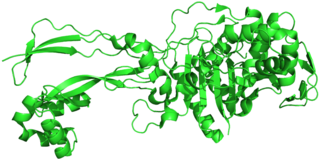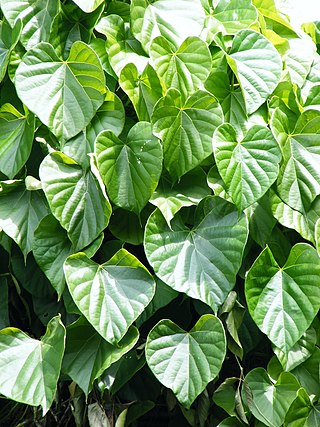Peptidoglycan or murein is a unique large macromolecule, a polysaccharide, consisting of sugars and amino acids that forms a mesh-like peptidoglycan layer (sacculus) that surrounds the bacterial cytoplasmic membrane. The sugar component consists of alternating residues of β-(1,4) linked N-acetylglucosamine (NAG) and N-acetylmuramic acid (NAM). Attached to the N-acetylmuramic acid is an oligopeptide chain made of three to five amino acids. The peptide chain can be cross-linked to the peptide chain of another strand forming the 3D mesh-like layer. Peptidoglycan serves a structural role in the bacterial cell wall, giving structural strength, as well as counteracting the osmotic pressure of the cytoplasm. This repetitive linking results in a dense peptidoglycan layer which is critical for maintaining cell form and withstanding high osmotic pressures, and it is regularly replaced by peptidoglycan production. Peptidoglycan hydrolysis and synthesis are two processes that must occur in order for cells to grow and multiply, a technique carried out in three stages: clipping of current material, insertion of new material, and re-crosslinking of existing material to new material.

Lysozyme is an antimicrobial enzyme produced by animals that forms part of the innate immune system. It is a glycoside hydrolase that catalyzes the following process:

Lactoferrin (LF), also known as lactotransferrin (LTF), is a multifunctional protein of the transferrin family. Lactoferrin is a globular glycoprotein with a molecular mass of about 80 kDa that is widely represented in various secretory fluids, such as milk, saliva, tears, and nasal secretions. Lactoferrin is also present in secondary granules of PMNs and is secreted by some acinar cells. Lactoferrin can be purified from milk or produced recombinantly. Human colostrum has the highest concentration, followed by human milk, then cow milk (150 mg/L).

Penicillin-binding proteins (PBPs) are a group of proteins that are characterized by their affinity for and binding of penicillin. They are a normal constituent of many bacteria; the name just reflects the way by which the protein was discovered. All β-lactam antibiotics bind to PBPs, which are essential for bacterial cell wall synthesis. PBPs are members of a subgroup of enzymes called transpeptidases. Specifically, PBPs are DD-transpeptidases.

Tinospora cordifolia is a herbaceous vine of the family Menispermaceae indigenous to tropical regions of the Indian subcontinent. It has been used in Ayurveda to treat various disorders.

Exportin-5 (XPO5) is a protein that, in humans, is encoded by the XPO5 gene. In eukaryotic cells, the primary purpose of XPO5 is to export pre-microRNA out of the nucleus and into the cytoplasm, for further processing by the Dicer enzyme. Once in the cytoplasm, the microRNA can act as a gene silencer by regulating translation of mRNA. Although XPO5 is primarily involved in the transport of pre-miRNA, it has also been reported to transport tRNA.

Peptidoglycan recognition protein 2(PGLYRP2) is an enzyme, N-acetylmuramoyl-L-alanine amidase (NAMLAA), that hydrolyzes bacterial cell wall peptidoglycan and is encoded by the PGLYRP2 gene.

Peptidoglycan recognition protein 1, PGLYRP1, also known as TAG7, is an antibacterial and pro-inflammatory innate immunity protein that in humans is encoded by the PGLYRP1 gene.

Lactoperoxidase is a peroxidase enzyme secreted from mammary, salivary and other mucosal glands including the lungs, bronchii and nose that functions as a natural and the first line of defense against bacteria and viruses. Lactoperoxidase is a member of the heme peroxidase family of enzymes. In humans, lactoperoxidase is encoded by the LPO gene.
Pathogenesis-related (PR) proteins are proteins produced in plants in the event of a pathogen attack. They are induced as part of systemic acquired resistance. Infections activate genes that produce PR proteins. Some of these proteins are antimicrobial, attacking molecules in the cell wall of a bacterium or fungus. Others may function as signals that spread “news” of the infection to nearby cells. Infections also stimulate the cross-linking of molecules in the cell wall and the deposition of lignin, responses that set up a local barricade that slows spread of the pathogen to other parts of the plant.

Peptidoglycan recognition proteins (PGRPs) are a group of highly conserved pattern recognition receptors with at least one peptidoglycan recognition domain capable of recognizing the peptidoglycan component of the cell wall of bacteria. They are present in insects, mollusks, echinoderms and chordates. The mechanism of action of PGRPs varies between taxa. In insects, PGRPs kill bacteria indirectly by activating one of four unique effector pathways: prophenoloxidase cascade, Toll pathway, IMD pathway, and induction of phagocytosis. In mammals, PGRPs either kill bacteria directly by interacting with their cell wall or outer membrane, or hydrolyze peptidoglycan. They also modulate inflammation and microbiome and interact with host receptors.
Alice Vrielink is a structural biologist and Professor of Structural Biology in the School of Molecular Sciences at the University of Western Australia. She is known for her work determining the structures of macromolecules such as enzymes and nucleic acids.
Vinod Bhakuni (1962–2011) was an Indian molecular biophysicist and the head of the Molecular and Structural Biology Division of the Central Drug Research Institute (CDRI). He was the founder of the Protein Chemistry laboratory of CDRI and was known for his contributions to the study of protein folding. A recipient of the National Bioscience Award for Career Development, he was an elected fellow of the Indian Academy of Sciences, Indian National Science Academy and the National Academy of Sciences, India. The Council of Scientific and Industrial Research, the apex agency of the Government of India for scientific research, awarded him the Shanti Swarup Bhatnagar Prize for Science and Technology, one of the highest Indian science awards, in 2006, for his contributions to biological sciences.

Prof. R K Sinha is the Vice Chancellor of Gautam Buddha University, Greater Noida, Gautam Budh Nagar Under UP Government. He was the director of the CSIR-Central Scientific Instruments Organisation (CSIR-CSIO) Sector-30C, Chandigarh-160 030, India. He has been a Professor - Applied Physics, Dean-Academic [UG] & Chief Coordinator: TIFAC-Center of Relevance and Excellence in Fiber Optics and Optical Communication, Mission REACH Program, Technology Vision-2020, Govt. of India Delhi Technological University Bawana Road, Delhi-110042, India.

Deepak Thankappan Nair is an Indian Structural Biologist and a scientist at Regional Centre for Biotechnology. He is known for his studies on DNA and RNA polymerases. Deepak was a Ramanujan fellow of the Science and Engineering Research Board (2008–2013) and a recipient of the National BioScience Award for Career Development. The Council of Scientific and Industrial Research, the apex agency of the Government of India for scientific research, awarded him the Shanti Swarup Bhatnagar Prize for Science and Technology, one of the highest Indian science awards, for his contributions to biological sciences in 2017. He was inducted as a fellow of the Indian National Science Academy in December, 2022.

Sujata Sharma is an Indian structural biologist, biophysicist, writer and a professor at the Department of Biophysics of the All India Institute of Medical Sciences, Delhi. She is known for her studies in the fields of protein structure, drug design and drug resistance of bacteria. Her studies have been documented by way of a number of articles and ResearchGate, an online repository of scientific articles has listed 167 of them. She is also the author of the books, "Warriors in White", an autobiographical account of some COVID-19 Warriors at All India Institute of Medical Sciences, Delhi and other leading hospitals of India, including Prof Randeep Guleria, using a combination of modern medicine, astronomy and Vedic astrology, "The Secret of the Red Crystals", an autobiographical account of her days in AIIMS Delhi. and "A Dragonfly's purpose", which is an autobiographical account of her recovery from an autoimmune disease, Guillain Barre Syndrome. The Department of Biotechnology of the Government of India awarded her the National Bioscience Award for Career Development, one of the highest Indian science awards, for her contributions to biosciences, in 2011. She is also a recipient of the Woman Scientist Award of the Biotech Research Society of India and the National Young Woman Bioscientist Award of the Department of Biotechnology which she received in 2006 and 2007 respectively. In 2020, she was awarded the Kalpana Chawla Excellence award, for her contributions in science. This award is instituted in the memory of the first Indian woman astronaut, Kalpana Chawla to go on space missions.
Professor Pravindra Kumar is an Indian biophysicist, bioinformatician, biochemist and Professor & Head Department of Biosciences and Bioengineering, Indian Institute Of Technology–Roorkee (IIT–Roorkee) India. He is known for his work on protein-protein interactions, protein engineering and structure-based drug design. Prof. Pravindra Kumar's primary research interest lies in studying Bacterial enzymes and pathways involved in the degradation of toxic aromatic compounds, such as PCBs, dibenzofuran, chlorodibenzofurans, DDT, dyes, and plastics/plasticizers. He focuses particularly on oxidoreductases enzymes due to their unique ability to catalyze challenging reactions, with a special emphasis on understanding their catalytic mechanisms and structural basis for guiding protein engineering. One notable achievement of his research group is the successful engineering of dioxygenases capable of metabolizing various toxic compounds, including those found in plastics.

Peptidoglycan recognition protein 3 is an antibacterial and anti-inflammatory innate immunity protein that in humans is encoded by the PGLYRP3 gene.

Peptidoglycan recognition protein 4 is an antibacterial and anti-inflammatory innate immunity protein that in humans is encoded by the PGLYRP4 gene.

Roman Dziarski is a Polish-born American immunologist and microbiologist. He is best known for his research on innate immunity and bacterial peptidoglycan, for discovering the family of human peptidoglycan recognition proteins, which comprises PGLYRP1, PGLYRP2, PGLYRP3, and PGLYRP4, and for defining the functions of these proteins.













